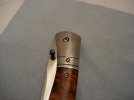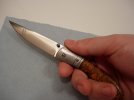Kohai999
Second Degree Cutter
- Joined
- Jul 15, 2003
- Messages
- 12,554
Spoken like a snob. Bah. You can't speak for everyone in New England. This is yours and a number of other's way. And if you are really looking for outside opinions (only you can create the answer), then these comments are valid, whether you choose to use them or not.Coop
No, that is not true, Jim!
No one disputes the "Arkansaw" style of 'smithing, or fails to give it credit to its' origins, right?
The "New England" style goes back to Jim Schmidt, Wayne Valachovic and a few others. It was brought to the forefront by McHenry/Williams with their upscale automatics, and continues to be practiced by many, many makers.
The solid spine is a hallmark of this style, so Chuck is not being a snob at all, but remaining true to a style that he practices.
Which is not to say that R.J. Martin does not make a "New England" knife, but it is not "New England" style.
Everybody get this?
As far as the studs go, Chuck, look seriously at those from Sheffield. I think those are about as good as it gets, but maybe some checkering would be the cherry on top.
Best Regards,
STeven Garsson


